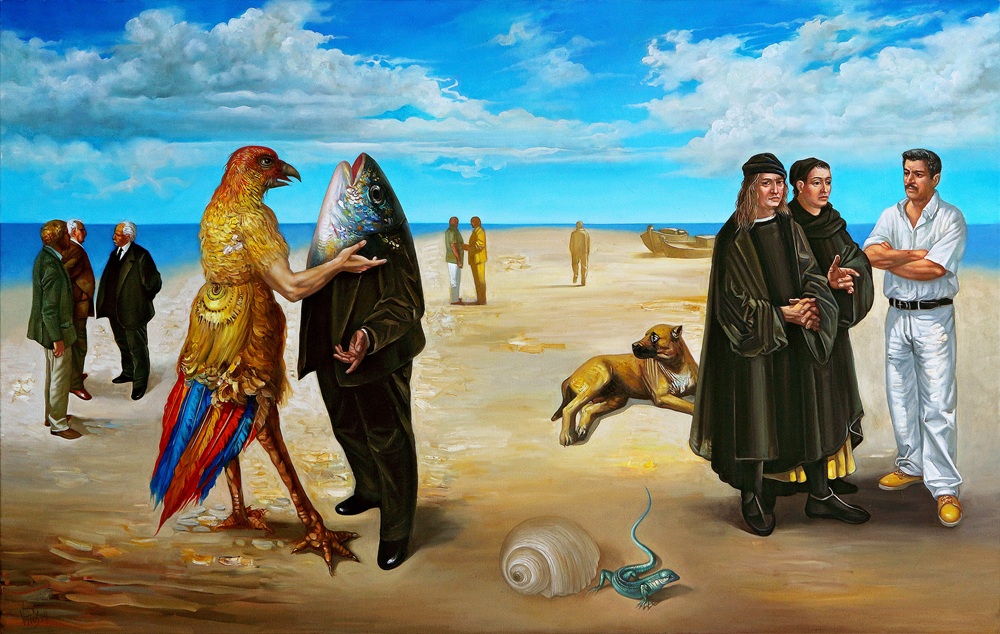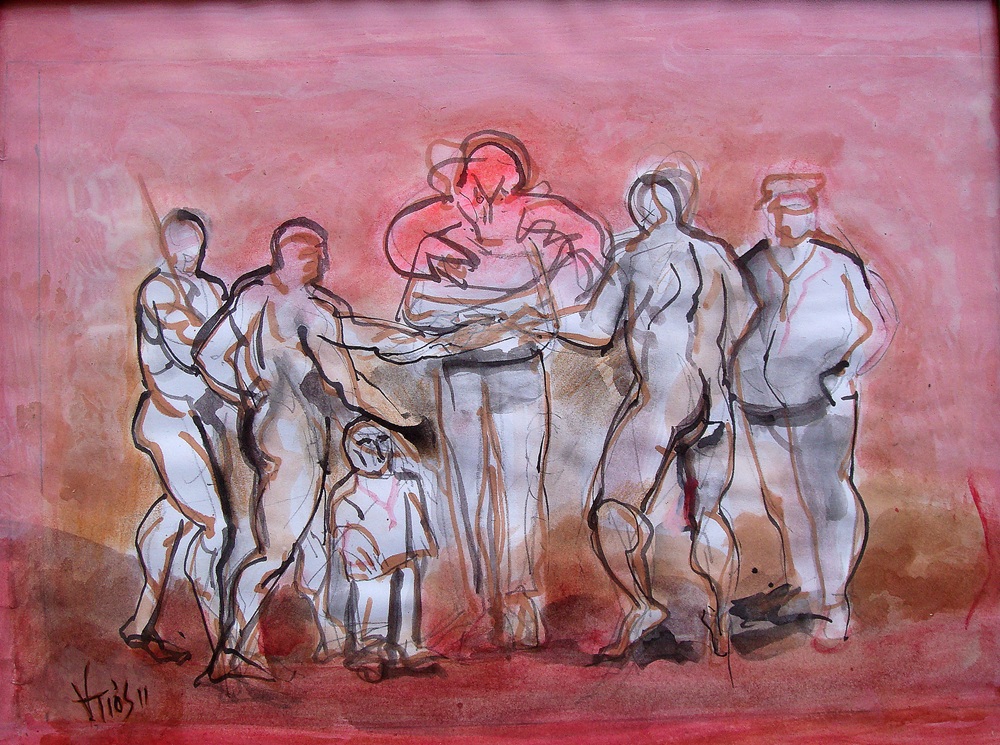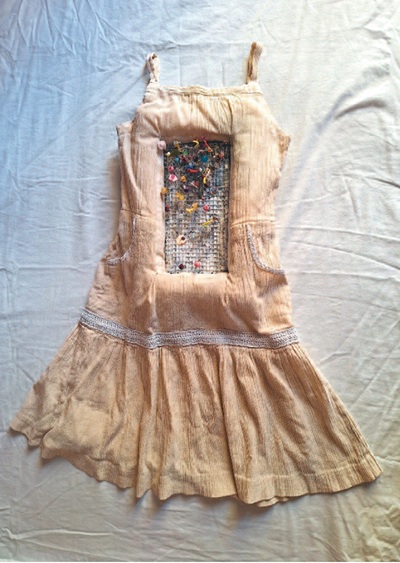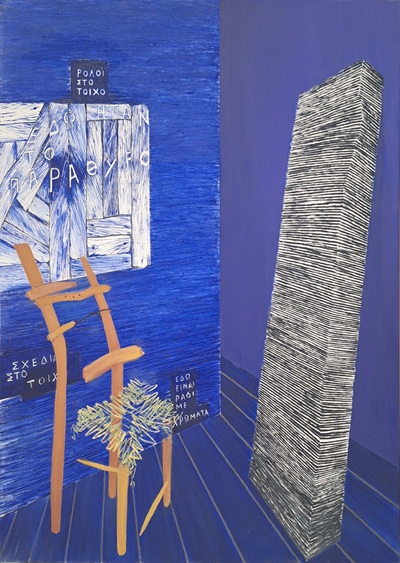
The Braggart Contemporary Gallery presents a solo exhibition by artist Kostas Diou, entitled “Paintings of a Scattered Life” [From the narrative by N.G. Pentzikis, “Architecture of Scattered Life”] from November 5-27, 2025, at art box Papakyriazi 55 & Skarlatos Soutsou in Larissa. The opening and presentation by art historian and exhibition curator Manos Stefanidis will take place on Friday, November 14, at 7:00 p.m.
We knew that painting tells stories without using words. We also knew that its images—even the most instinctive or abstract ones—dynamically presuppose speech and thought or refer, indirectly or directly, to texts. Whether texts already written or yet to be written. In other words, they refer either to lived memories or to dreams that one sees with one’s eyes closed or open. After all, painting has the ability to show images of the future in the ways of the past.
In any case, painting and language, i.e., text, have a relationship similar to that between poetry and music. One completes the other. It cannot be otherwise. Because what we call inspiration springs from the same dark and unknown source of the subconscious. From that shadow that conceals the light. From the deepest core of existence. From the source of colors and words and sounds and images and music. It cannot be otherwise. It is also worth mentioning here that the more autonomous and self-sufficient the arts appear, the more directly and effortlessly they communicate with each other. The more essentially, I would say, they complement each other. Or, better yet, they “interpret each other.”

What comes to mind right now is the unexpected (?) dialogue between Ramon and Tiepolo. Or, Debussy and Monet. Prime examples of these “connections” are, of course, tragedy in the ancient world and opera in the culture that flourished in the West during the Renaissance. Wagner’s Gesamtkunstwerk, the total work of art.
The paintings of Kostas Ntios, a truly great artist in my opinion, but little known outside the walls of our artistic Jerusalem, richly contain all of the above elements: Namely, a deep knowledge of Western European art—he studied in Paris – alongside a keen balance in his personal idiom between emotion and rationality, experience and instinct, respect and, at the same time, bold questioning of any tradition. Whether native or imported. But even then, all these qualities would be dry and superficial if we did not add to the above his outstanding ability to tell magical stories with his enigmatic images, resurrecting the past by bringing his dead friends back to life and making his hometown, Kozani, the center of a peculiar universe that, for some strange reason—I personally don’t have an easy answer—concerns us all.
We are equally interested in the adventures and the fate of the heroes who masterfully intersect in his compositions. Where the narrative-realistic becomes visual-aesthetic. And always with the bittersweet feeling of the unrealized that some of Mozart’s piano sonatas have (especially the ninth, which he wrote at a very young age in Mannheim after a failed love affair). But also humor in the face of human futility. Dew’s form, often epic in the manner of the old masters, can adequately serve both the overall idea of the painting and its small details. Sometimes a miniaturist and sometimes a muralist (as we say guitarist or drummer)!

In any case, his strange stories intersect and overlap like little pocket dramas, and his heroes continue to live from one work to the next like ghosts who refuse to descend into the underworld but insist on disturbing the sleep of the living. A wonderful lesson for younger creators. After all, whatever we say, the whole history of painting has to do with the adventure of memory. And a good painter, as is the case with Ntios, is distinguished by the way he handles this memory so that it concerns as many people as possible. Because every work of art begins in the hands of the artist but is completed in the soul and mind of anyone who can love it…
Bio
Kostas Ntios was born in Siatista, Kozani, in 1959. He studied at the Ecole Nationale Supérieure des Beaux-Arts in Paris (1978-1984), studying sculpture in César’s workshop and painting in Olivier Debré’s workshop. From 1996 to 2002, he was artistic director at the Visual Arts Workshop of the Municipality of Kozani. In this capacity, he curated two exhibitions of works by adults from the workshop in Larissa and Ioannina. From 1991 to 2021, he worked in secondary education as an art teacher. In 2001, he published a book entitled “Painting Units from 1987-2001.” In the 2010s, he worked on the theme of the Apocalypse of John and published a book entitled “Images of the Apocalypse” (2010). In recognition of his contribution to modern Greek visual arts, Nikos Psimmenos, professor emeritus of philosophy at the University of Ioannina, published a study entitled “Approaches to the Work of Kostas Ntios” (Dodoni, 2010). In 2018, he was honored by the Municipality of Kozani for his work, and in 2019 by the Municipality of Siatista for decorating the Papageorgiou High School with his works. Since 1991, he has been a contributor to the literary magazine “Paremvasi,” writing articles and creating portraits of poets for its literary conferences. In 2025, the writer Vasilis P. Karagiannis published the book “Portraits of Kostas Ntios- Writers and others on the floor”. His works have been published as covers for books by Greek writers and in calendars. From 1991 to 2010, he collaborated with the “Eirmos” gallery in Thessaloniki. He exhibited his works in Ermoupoli, Syros, Kavala, Florina, and Athens.
Venue: Braggart Contemporary Art Gallery
Opening Night: Friday 14 November 2025 at 19:00
Curator: Manos Stefanidis
Emeritus Professor, National and Kapodistrian University of Athens, Art Historian.
Duration: 05-27 November 2025
Opening hours: Closed on Mondays, Wednesday and Friday 12:00-20:00, Tuesday and Thursday 10:00-14:00 and Saturday 11:00-14:00
Where: Papakyriazi 55 Larisa
Τ:2416007422 Μ:6908622813







Leave A Comment